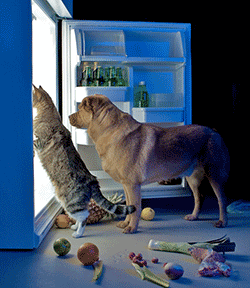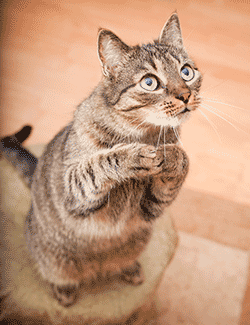Common feeding problems
Apart from occasional fussy tendencies with some foods, cats rarely have feeding problems, but if they do there is usually a common cause and simple solution

Fussy felines
Pet store workers often hear customers stating that "Felix won't eat cat food, we've tried everything and he only eats chicken or tuna". The problem here might be that Felix is getting too much chicken and tuna, and he knows that turning down cat food will eventually mean he gets chicken or tuna. It doesn't take long for cats to work out that different foods can be put on the menu if a good protest is made. Meat treats like this should be only fed occasionally, as soon as they start happening several times a week, or on consecutive days, there is a chance your cat will start demanding them. Once your cat gets on the path to becoming a fussy eater the problem can escalate and even get to the point where your cat refuses to eat anything even if it causes illness.
The best cure is prevention, and providing your cat with many different varieties of prepared commercial foods will get your cat used to different flavours, and reduce any fussy tendencies. If your cat does refuse to eat perfectly good food, don't immediately give an alternative, leave it until the next mealtime and this will send the 'you get what you are given' message.
Refusal to eat
If your cat is not eating, it may be a case of choosing a different food, but there are other factors which can discourage a cat from eating. The first thing to look at is where your cat has its food put down. If the area is noisy, busy, or prone to disturbance (is it by a door etc..) your cat may feel uncomfortable eating there. Many cats will not eat food if it is too cold, and this can be a common problem with feeding open tins from the fridge. This behaviour stems from a natural instinct to eat freshly killed meat, which is at body temperature, if it is too cold or hot, it could be a sign for a wild cat that the meat has gone off. If you are feeding from the fridge, try warming the food up a little first. It only needs to be very mildly warm (30-38C) this will be a pleasing temperature and will also release more smells to entice your cat. Finally, it may be something as simple as changing the bowl, believe it or not some cats don't like the 'feel' of some bowls, or even the noise they make when moved. To get a cat used to the feeding area and bowls you could try hiding tasty bits of food around the area, encouraging a natural hunting instinct and associating the area with feeding.

Cats know what and how they can get food from their owners
Overeating
Cats usually regulate their own feeding and rarely end up overweight, unlike dogs which often just eat whatever is given to them. However, overeating does exist and if your cat starts becoming a bit heavy, you should take action for the sake of your cats health. There are no special steps, just feed your cat less and cut out any extra treats. You can purchase special diet foods for overweight cats which may help, but it is important to treat the cause as well and cut down on food quantities. It may also be possible that your cat is getting extra food or treats from elsewhere, maybe another member of the household or an over friendly neighbour. How much a cat should weigh varies on its age, breed, and general size but you can weigh your cat easily by weighing yourself with and without the cat, and working out the difference. By knowing your cats weight you can monitor any weight gains or losses and also use the feeding advice on commercial cat food packets, which is often done by weight.
Food stealing
A cat which has been trained early on to stay off kitchen tops or tables, will normally continue to avoid them with only the need for an occasional reminder. Most cats are a bit more inquisitive and if allowed onto kitchen surfaces, they will soon discover dirty plates with food left on. Keep trying to tell your cat it is not allowed on surfaces by performing a loud clap or squirt of water whenever the cat attempts to jump up. Some cats. if they know food is up there, will just find a way up when you are not looking. In these cases your only option is to put plates straight into the dishwasher, or bowl of water, so that there is never food around. In most cases, cats learn about food on plates when they are given little bits of food from owners who give in to begging. The only way to stop a cat from begging for food, or trying to take food from a humans plate, is to make sure that no-one in the house is feeding the cat from a plate, or whilst they are eating. If you have to feed your cat bits of your food, wait till you have finished, cleared away plates, and then put the treats in your cats bowl.


